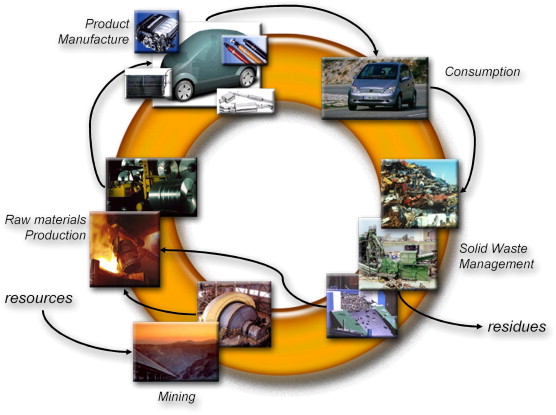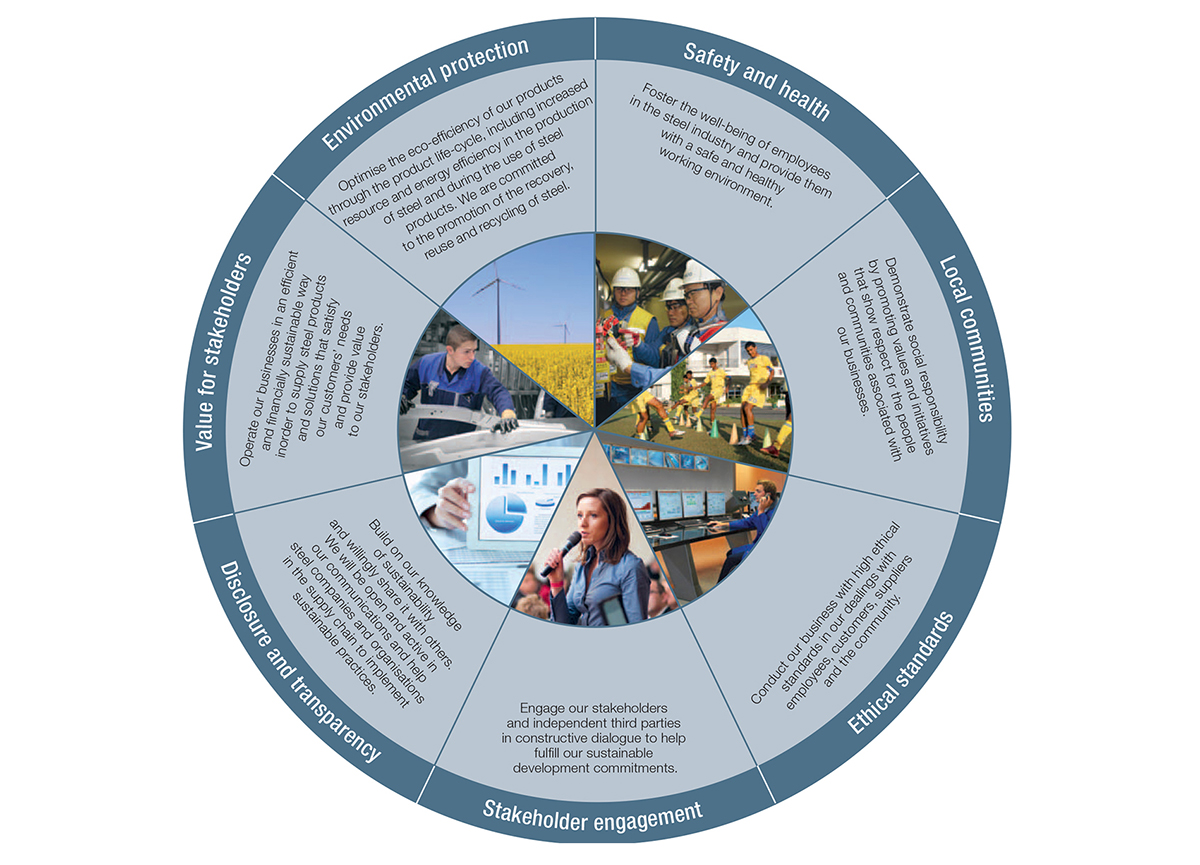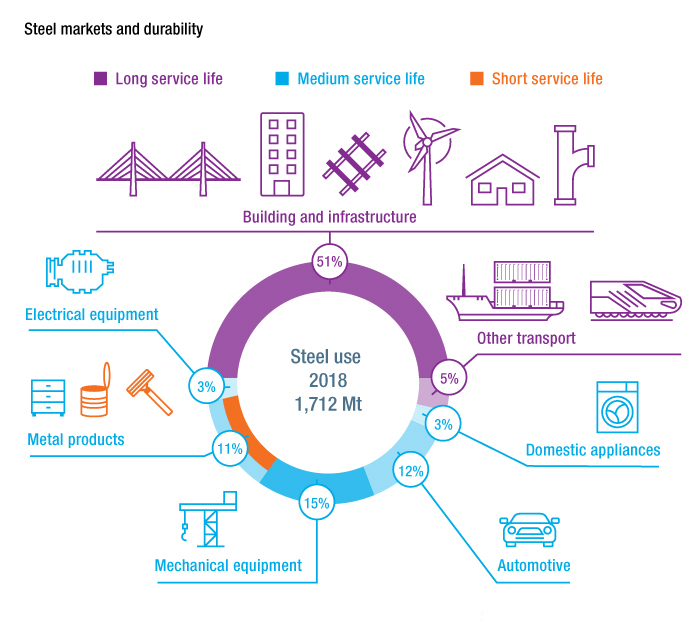Sustainable Development in the Steel Industry – the 4Rs
| ✅ Paper Type: Free Essay | ✅ Subject: Engineering |
| ✅ Wordcount: 2583 words | ✅ Published: 03 Nov 2020 |
Introduction
Greenhouse gas emissions and energy consumption are major environmental concerns for steel production, and the steel industry contributes significantly to CO2 emissions (Tata Steel Europe, 2020), accounting for around 997 kg per ton of steel, or 4% to 5% of global CO2 emissions, over 60% of which are emitted prior to steelmaking (Zhang, A., et al, 2018).
The around 95% of ore-based steel produced in blast furnaces (BF-BOF), use coking coal as both reduction agent and heat energy source, while the remaining approximately 5% is produced via direct reduction (DRI) in electric arc furnaces (EAF) (Energy Technology Perspectives, 2017).
The typical solid waste management model manufacturing process tends to be linear in its extraction of maximum practical benefit from waste products and generating minimum waste to comply with environmental legislation (Waste Framework Directive, 2008).
The strategies for achieving a circular economy, however – maintaining sustainable development in the steel industry and meeting the ever-growing scarcity of energy and materials – are the 4Rs of reducing, reusing, recycling and restoring material, which it is the goal of this paper to study, discuss and draw conclusions from.
A circular strategy for the steel industry
As an integral part of the complete steel cycle of mining, steel production, recycling of end-of-life (EoL) consumer goods and consumer product design for recycling, the design of a steel product determines the selection of materials and its complexity – welded, glued, alloyed or layered – all of which directly affect the recyclability of the steel and determine whether or not the material cycle or loop can be fully closed and true circularity achieved (Reuter, et al, 2007).

Fig. 1 Simplified steel cycle. (Source: Minerals Engineering, Vol. 20, Issue 9, August 2007, pp. 819-821)
The World Steel Association’s seven sustainability principles (World Steel Association, 2020) contribute both directly and indirectly to the U.N. Sustainable Development Goals: safety and health, local communities, value for stakeholders, stakeholder engagement, environmental protection, disclosure and transparency, and ethical standards.

Fig, 2 The World Steel Association’s seven sustainability principles
Source: World Steel Association
Methods used by the steel industry to dispose of waste
More than 8 out of 10 steel beams are made from scrap (Sustainable in Steel, 2020). The steel industry uses scrap to produce new steel, the products from which contain a quarter to a hundred percent recycled content (World Steel Association Fact Sheet, 2016). Recycling steel scrap, rather than mining virgin ore to manufacture new steel (ore is still mined to supplement the production of steel and its co-products) dramatically reduces costs and energy consumption and, in turn, the emission of greenhouse gases otherwise released in the processing and manufacturing steel from virgin ore. A shift from ore to scrap-based production would significantly reduce the volume of emissions.
Recycling and the future of steel scrap

Fig. 3 The attributes of benefits of steel recycling
Source: World Steel Association
Minimising waste and ensuring resources remain in use for as long as possible are key to achieving a sustainable circular economy. Steel’s ready recyclability is due to its intrinsic magnetism, making it the world’s most recycled, sustainable material. Yet, despite all available steel scrap being recycled, there is still insufficient scrap available to meet the demand for new steel products. However, the World Steel Association (Çiftçi, Raw Materials Markets, 2018) has argued that growing scrap availability worldwide, with China at the forefront, will potentially be a game changer for the future of steelmaking.
It should be assessed whether total demand for steel could be reduced or met by more scrap-based recycled steel that is less carbon-intensive than ore-based (primary) production. (Energy Technology Perspectives, 2020).

Fig. 4 Historical and projected global scrap availability (in millions of tonnes) 1950-2050
Source: World Steel Association

Fig. 5 Historical and projected global scrap availability (in millions of tonnes) 2000-2050
across the European Union, North American Free Trade Association, China and the rest of the world
Source: World Steel Association
Decarbonisation of the steel industry
The decarbonisation of the global economy as a steel-intensive process is based, in part, on the 100%, infinitely-recyclable characteristics of steel and the development of breakthrough technologies, such as iron ore reduction with renewable hydrogen reducing the need for coking coal.
Contributory approaches to decarbonisation include reducing demand through leaner design and/or alternative construction technologies that use less steel to achieve the same level of service or stability, working towards the circularity of materials by increasing the use of scrap, gradually shifting supply towards secondary steel produced in EAFs powered by renewable energy, and developing and implementing technologies generating zero-emission primary steel to replace emission-intensive products from conventional blast furnaces. Decarbonised, zero-emission, alternative technologies and practices for the energy and transport sectors are becoming increasingly available yet require significant investment in R&D to demonstrate and promote them (Lechtenböhmer et al. 2016).
Again, in Lechtenböhmer et al. (2018)’s view, the entire steel-making process could potentially be decarbonised using yet-to-be-commercially viable technologies for achieving zero-emission primary steel, include direct electrolysis of iron ore into iron (electrowinning) which could virtually eliminate process emissions and significantly increase demand for electricity, direct hydrogen reduction, with hydrogen replacing natural gas or coal as a reduction agent (Salzgifter low CO2 steelmaking – SALCOS and HYBRIT fossil-free steel) and producing sponge iron for steel feedstock in EAFs, EAFs powered by zero-carbon energy, and coking coal or natural gas fed into conventional steel-making processes with sustainable charcoal as a fuel and reduction agent (Energy Transitions Commission, Sectoral Focus – Steel, 2018). Other decarbonisation technologies include charcoal in BFs and BOFs, scrap-based EAFs, gas-based or hydrogen-based DRI (direct reduced iron) and iron electrolysis.
The key ideal paths to decarbonisation are to avoid the use of carbon through hydrogen-based reduction of iron ore, avoiding creating CO2 and producing water; carbon capture with storage (CCS), which generates a clean, concentrated CO2 stream that can be captured and stored, and carbon capture and use (CCU), which uses the components of co-product gases from existing processes to produce fuel or input material for the chemical industry.
Breakthrough technologies
The International Energy Agency (IEA)’s technological strategy for the steel industry is to decouple increased steel production from related CO2 emissions and move towards primary net-zero carbon steel production, with CO2 emission reduction in steelmaking being implemented on a global scale. Making the substantial CO2 reductions will necessitate technology transfer, collaboration and breakthrough technologies, and a reduction in CO2 from steel production and GHG emissions during the life cycle of products that use steel are established priorities.
Developing breakthrough technologies such as HIsarna, a low-carbon steelmaking alternative that can reuse up to 50% of scrap material, contributes significantly to reducing CO2 emissions by increasing direct reuse of steel in materials rather than re-melting it into new steel.

Fig. 6 The HIsarna process makes the coking/agglomeration BF process redundant
Source: Tata Steel
One such technology is the concept Future Steel Vehicle (FSV) project (WorldAutoSteel, 2020) completed seven years ago using the latest steel grades and technologies, which has developed fully-engineered, steel-intensive designs for electric vehicles to reduce greenhouse gas emissions over their entire life cycle. Over a third lighter than conventional steels, it reduces fuel consumption and saves 8kg of CO2 emissions for every kg of advanced, high-strength steel used in other modern cars, at no additional cost and with no compromise to safety.
Another breakthrough technology with the potential to totally transform manufacturing is 3-D metal printing, or additive manufacturing, where printers can lighten and strengthen large or more complex metal parts more conventional metal manufacturing methods are unable to, quickly, inexpensively, on demand, and with more precise control of the metal’s microstructure. 3-D printing and powder metallurgy will reduce the amount of new scrap generation through improved product design.
In the short term, there would be little need for manufacturers to keep large inventories, and in the long term, large factories manufacturing limited product ranges could downsize to smaller factories manufacturing more bespoke products. For example, Modumetal has developed an additive manufacturing process that can create nano-laminated materials that control material interfaces at the nanoscale, grow nanolaminate structures organically and improve the structural, corrosion and high temperature performance of coatings, bulk materials and parts (Modumetal, 2020).

Fig. 6 Steel markets, durability and use 2018
Source: World Steel Association
Potential challenges and obstacles for emission-intensive industries in implementing technologies
Decarbonised technologies are, however, in short supply, and deep decarbonisation technologies in emission-intensive industries are in the relatively early stages of development, particularly where these technologies involve full decarbonisation in production and extensive infrastructure to implement them on an industrial scale, and technologies requiring major investment often fail in the demonstration or commercialisation phase, giving rise to doubt as to their reliability.
Another potential obstacle could lie in technological inertia, where prolonged decision-making and paucity of investment in emission-intensive industries present an impediment to the fast-track implementation of breakthrough technologies. There may also be concerns regarding the competitiveness of these technologies, where other similar raw materials have significantly lower operating costs.
Moreover, complex global value chains may delay the supply of basic end-use materials and create a lag in recycling rates. Deep decarbonisation affects both production and increased reuse and recycling in an increasingly circular economy (Wesseling et al. 2017)
Discussion
Increasing steel recycling involves addressing the issues of steel losses in unrecycled steel from structures inaccessible or too corroded to use, old scrap lost or scrap that ends up in landfill, and new scrap lost in manufacture but not collected and recycled, losses in the re-melting process.
A point of controversy is where Sustainable in Steel (2020) claims that steel scrap can be used to make any standard steel grade, with no need for ‘downcycling’, and that new steel retains its properties and suitability for high-performance applications whereas, according to Energy Technology Perspectives (2017), there is unavoidable downcycling due to recycled steel containing tramp elements: typically lower-quality, lower-value steel than the original considerably limits the range and properties of scrap-based steel applications. This apparent contradiction requires clarification. Despite the steel not being fully recycled, however, recycling is not impeded, provided there is a demand for the more basic types of steel the downcycled steel can be used for. Extensive copper contamination limits the properties of the steel scrap to be used to produce certain alloys, requiring dilution with ore-based steel to reduce copper content.
Conclusion
Complete decarbonisation of the steelmaking industry by 2050 is feasible. Net-zero CO2 emissions from steel can be achieved through expanding and improving recycling and improving the design of products in terms of material efficiency and circularity, as well as increasing the reuse of steel-based products in a circular economy, improving energy efficiency through the use of furnace gas to power other equipment, and coke dry quenching as a heat recovery system to generate power or steam.
Recommendations are to develop and implement hydrogen-based DRI and new technologies to reduce the cost of carbon capture from BFs and BOFs, and to develop and produce higher-quality, higher-value steel recycling, as well as to meet the 2040 commitment to 100% green steel for all state-funded construction and infrastructure, introduce and tighten up on regulations governing the embedded carbon intensity of steel-based products, for governments to agree together to impose a carbon tax on steel production; and for the steel industry to promote and implement the design of green steel standards.
Product design could be adapted to facilitate reuse of components and increase recyclability, modular buildings could reduce the amount of construction waste, electronic goods could be redesigned for easier extraction of metals from scrapped devices, and steel companies could work with production industries to redesign and standardise durable goods for reuse or refurbishment.
Recycling could, in addition, be made mandatory for private and commercial consumers, while regulation could require product design to facilitate disassembly and metal extraction, governments would need to introduce legislation to reduce the production of waste and incentivise higher scrap reuse, and life cycle assessments to gauge the true environmental impact of a product, might help governments institute complex recycling regulations (cf. Directives 2010/75/EU and 2012/135/EU).
References
- Çiftçi, B.B. (2018) The Future of Global Scrap Availability. World Steel Association Raw Materials Markets. [Blog] Available:
- https://www.worldsteel.org/media-centre/blog/2018/future-of-global-scrap-availability.html
- Commission Directive. (EC) No. 98 of 19 November 2008 on Waste (Waste Framework Directive) Official Journal. L 312, 22 November 2008.
- Commission Directive. (EU) No. 135 of 28 February 2012 on establishing the best available techniques (BAT) conclusions under Commission Directive 2010/75/EU [No. 75 of 24 November 2010] on industrial emissions for iron and steel production. Official Journal. L 70, 8 March 2012.
- Energy Technology Perspectives (2017). Catalysing Energy Technology Transformations. International Energy Agency. p. 443. [Online] Available: https://www.iea.org/reports/energy-technology-perspectives-2017
- Energy Transitions Commission (2018). How to reach net-zero carbon emissions from steel. Mission Possible: Reaching Net-Zero Carbon Emissions. ETC sectoral focus – Steel [Online] Available: http://www.energy-transitions.org/sites/default/files/ETC%20sectoral%20focus%20-%20Steel_final.pdf
- Lechtenböhmer, S., Nilsson, L.J., Åhman, M., Schneider, C. (2016) Decarbonising the energy intensive basic materials industry through electrification – Implications for future EU electricity demand. Energy, ScienceDirect [Online] Vol.115(3), pp. 1623-1631. Available: https://doi.org/10.1016/j.energy.2016.07.110
- Lechtenböhmer, S., Nilsson, L.J., Åhman, M., Bataille, C., Neuhoff, K., Fischedick, M., Solano-Rodriguez, B., Denis-Ryan, A., Stiebert, S., Waisman, H., Sartor, O., Rahbar, S. (2018) A review of technology and policy deep decarbonization pathway options for making energy-intensive industry production consistent with the Paris Agreement. Journal of Cleaner Production, ScienceDirect [Online] Vol.187, pp. 960-973. Available: https://doi.org/10.1016/j.jclepro.2018.03.107
- Mining & Metals in a Sustainable World 2050 (2015) World Economic Forum in collaboration with The Boston Consulting Group. [Online] Available: http://www3.weforum.org/docs/WEF_MM_Sustainable_World_2050_report_2015.pdf
- Modumetal Rewriting the rules on advanced lightweight materials. (n.d.) [Online] Available: https://www.modumetal.com/pages/aerospace-industry
- Nidheesh, P.V., Suresh Kumar, M. (2019) An overview of environmental sustainability in cement and steel production. Journal of Cleaner Production, Science Direct [Online] Vol. 231, pp.862-868. Available: https://www.sciencedirect.com/science/article/pii/S0959652619317871
- Reuter, M. A., Schaik, A. van (2007) Sustainable Steel. in Stahl und Eisen, March 2007. Conference: Proceedings of the 1st International seminar on Society & Materials, European Commission, Directorate General, Joint Research Centre, (Ed. Birat, J.-P., ArcelorMittal) Society and Materials (SAM1), Seville, 6-7th March 2007 ResearchGate [Online] Available: https://www.researchgate.net/publication/270284280_Sustainable_steel
- Sarkar, S. Mazumber, D. (2015) Solid wastes generation in the steel industry and their recycling potential. [Online] Paper presented at: Conference: Management & utilisation of wastes from metal processing industries and thermal power stations, organised by Millenium Institute of Energy & Environment Management at the Central Glass Ceramic Research Institute, Kolkata. pp. 1-14. Available: ResearchGate https://www.researchgate.net/publication/275654751_Solid_wastes_generation_in_steel_industry_and_their_recycling_potential
- Sustainable in Steel (n.d.) [Online] Available: https://www.sustainableinsteel.eu
- Tata Steel (n.d.) HIsarna: game changer in the steel industry. [Online] Available: https://www.tatasteeleurope.com/static_files/Downloads/Corporate/About%20us/hisarna%20factsheet.pdf
- Tata Steel (n.d.) Steel for a sustainable future. [Online] Available: https://www.tatasteeleurope.com/en/sustainability/steel-for-a-sustainable-future
- Wesseling, J., Lechtenböhmer, S., Åhman, M., Nilsson, L., Worrell, E., Coenen, L. (2017) The transition of energy intensive processing industries towards deep decarbonization: characteristics and implications for future research. Renewable and Sustainable Energy Reviews. Science Direct [Online] Vol. 79, pp. 1303-1313. Available: https://www.sciencedirect.com/science/article/pii/S1364032117307906
- WorldAutoSteel (n.d.) Future Steel Vehicle. [Online] Available: https://www.worldautosteel.org/projects/future-steel-vehicle
- World Steel Association (2016) Fact Sheet [Online] Available: https://www.worldsteel.org/steel-by-topic/sustainability.html
- World Steel Association (2020) Recycling [Online] Available: https://www.worldsteel.org/steel-by-topic/sustainability/materiality-assessment/recycling.html
- Zhang, Q., Li, Y., Xu, J., Jia, G. (2018) Carbon element flow analysis and CO2 emission reduction in iron and steel works. Journal of Cleaner Production. [Online] Vol.172, pp.709-723. Available: https://doi.org/10.1016/j.jclepro.2017.10.211
Cite This Work
To export a reference to this article please select a referencing stye below:
Related Services
View allDMCA / Removal Request
If you are the original writer of this essay and no longer wish to have your work published on UKEssays.com then please click the following link to email our support team:
Request essay removal


